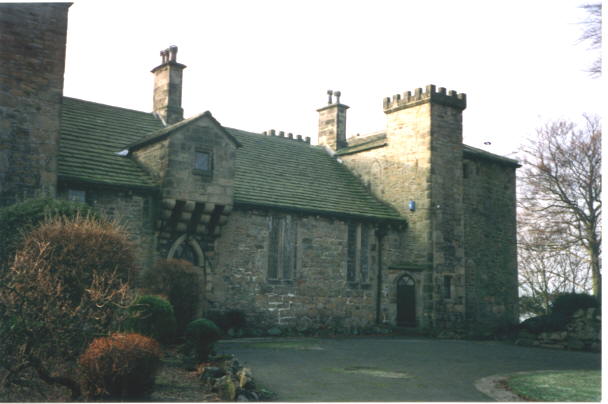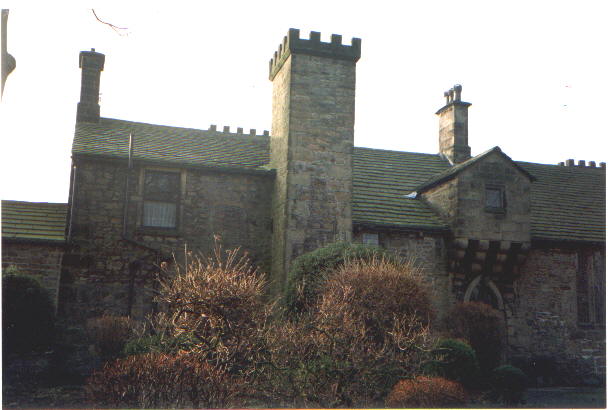

"Farnhill Hall is still very much in existence and .... the gardens are occasionally open to the public. Robert William Wrathall of Leicestershire has copies of photographs taken when the building was "listed" and also copies of some old photographs provided by the present residents of Farnhill Hall Farm House, the house built for William Wrathall, the son of Robert senior and Grandfather of Robert W Wrathall of Leicestershire."Derek provided a transcription of the "listing", dated 10 Sep 1954, which describes Farnhill Hall as follows:
"Manor house of C15 much altered C16 and C19. Rubble with slate roofs, hipped at right hand end. Now of 2 storeys but originally composed of a one-storey hall with chamber block and kitchen block at either end, in a single range. Ends of hall marked by 4 turrets, 2 on each front. The hall was lit by paired tall trefoil-headed lights, 2 pairs of which survive to right hand side of the doorway. Doorway is early C20 Gothic but defended by a small gabled machicolated dormer. The right hand block has a blocked 2-light round-headed window to ground floor and a blocked doorway facing the hall roof which may have served lost battlements.Derek made copies of the photographs which accompanied the listing, seen below. Derek also mentioned that Robert W. W. has a copy of the sale document and, as he recalls, it refers to Robert senior as "occupying" the Hall. The Farm, a nearby property used by the family, was rented from the local Urban District Council."At the rear the windows are all C19 or early C20 with slightly arched heads, mostly sashes. The interior (not seen) is said to contain a large elliptical-headed fireplace and woodwork of early C20 by Robert Thompson of Kilburn. Although much altered, this is a rare survival of a fortified manor house built in a single range, of which more remains to be discovered, and the building merits a high grade in consequence."


To add to the above information, Derek provided this extract from "The History and Antiquities of the Deanery of Craven, in the County of York" by Thomas Dunham Whitaker, LL.D., F.S.A., first published in 1878:
"FERNHILL, which carries its own etymology with it, as the situation of the manor-house on a round and dry knoll, such as the Filices (bracken or true ferns) delight in, proves the propriety of the name." The first mesne lords of this manor were the Fernhills, of whom Adam was party to the following very ancient charter, probably as old as King Stephen :
"Adam de F'nil d. et c. Deo et S'cto Hosp. Jer'l'm unum toft' in F'nil in quo Adam filius meus domum suam et grangia' sua' posuit --- scil' juxta fontem S'c'e Helene ; et duas acras --- unam i'fra sepe qu' Suward homo meus ad opus suum signavit desubt' fot'e --- T. Rob. Cap. W. de Stiuetona, Henrico f. Ade, Jo. de Cun', Rog. f. Hucidi, Hamo'e de B'dlaia."I can trace the Fernhills no lower than the reign of Edward II., when Robert de Fernhill was assisted by the bounty of his fellow-sufferers, the canons of Bolton, whose Compotus describes him as being "destruct' per Scotos."In the 9th of Richard II. [1385-6] I find a John de Coplay de Fernhill. He had a daughter and heir Margaret, who married an Eltoft, and had issue William Eltoft, living in the 4th of Henry V. In this name it continued till the 12th Charles I. [1636-7], when Isabel Eltoft married George Simeon, Esq. By these parties the manor of Farnhill was sold to Henry Currer, of Gawthorpe, etc., which Henry, or a son of the same name, sold it once more, about the year 1665, to Robert Benson, father of the first Lord Bingley ; and it is now vested in James Fox, Esq., the present representative of the family."